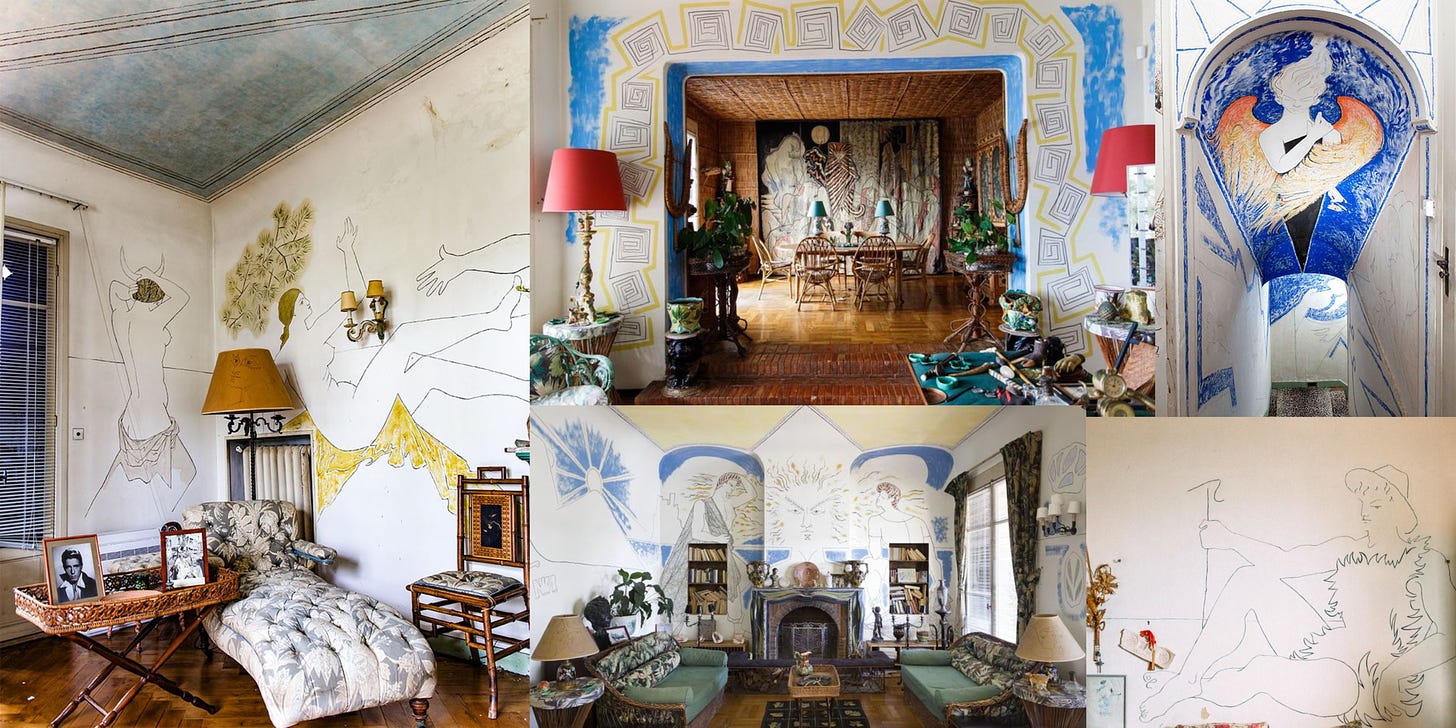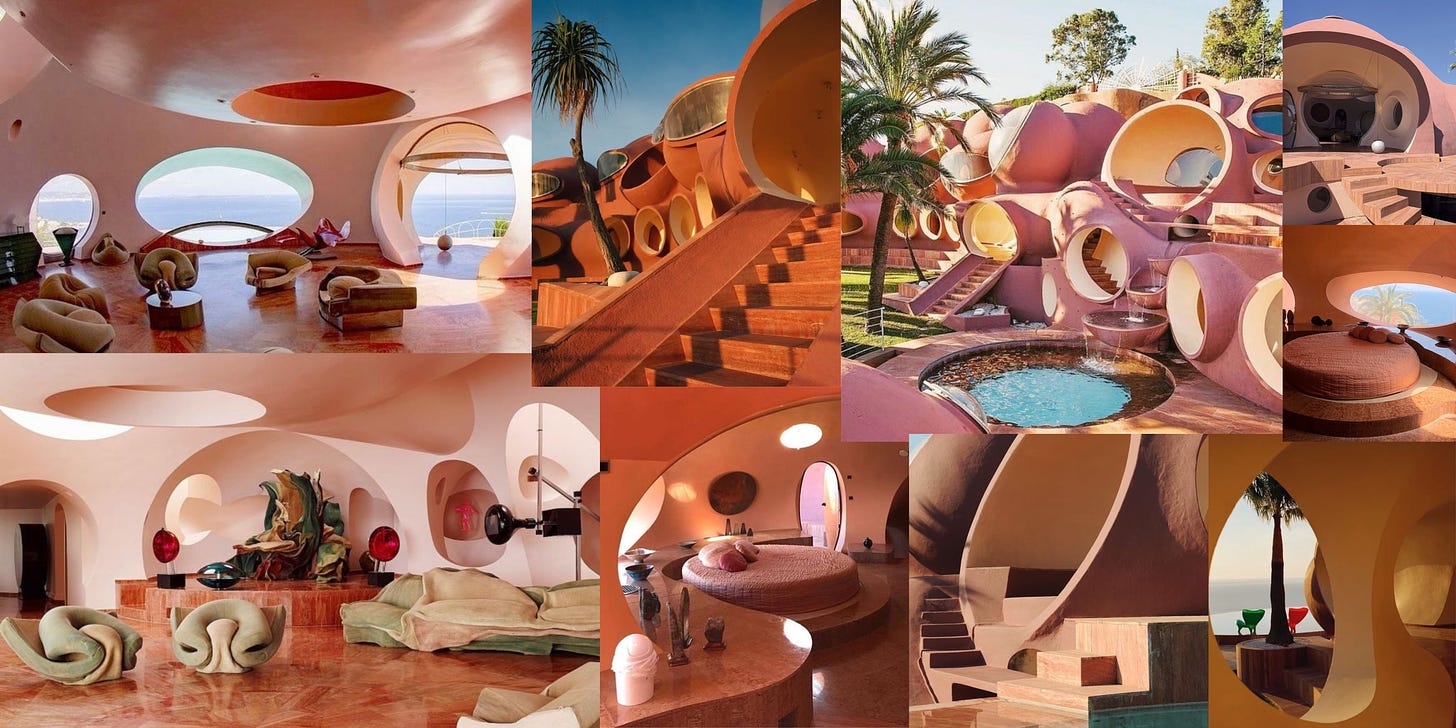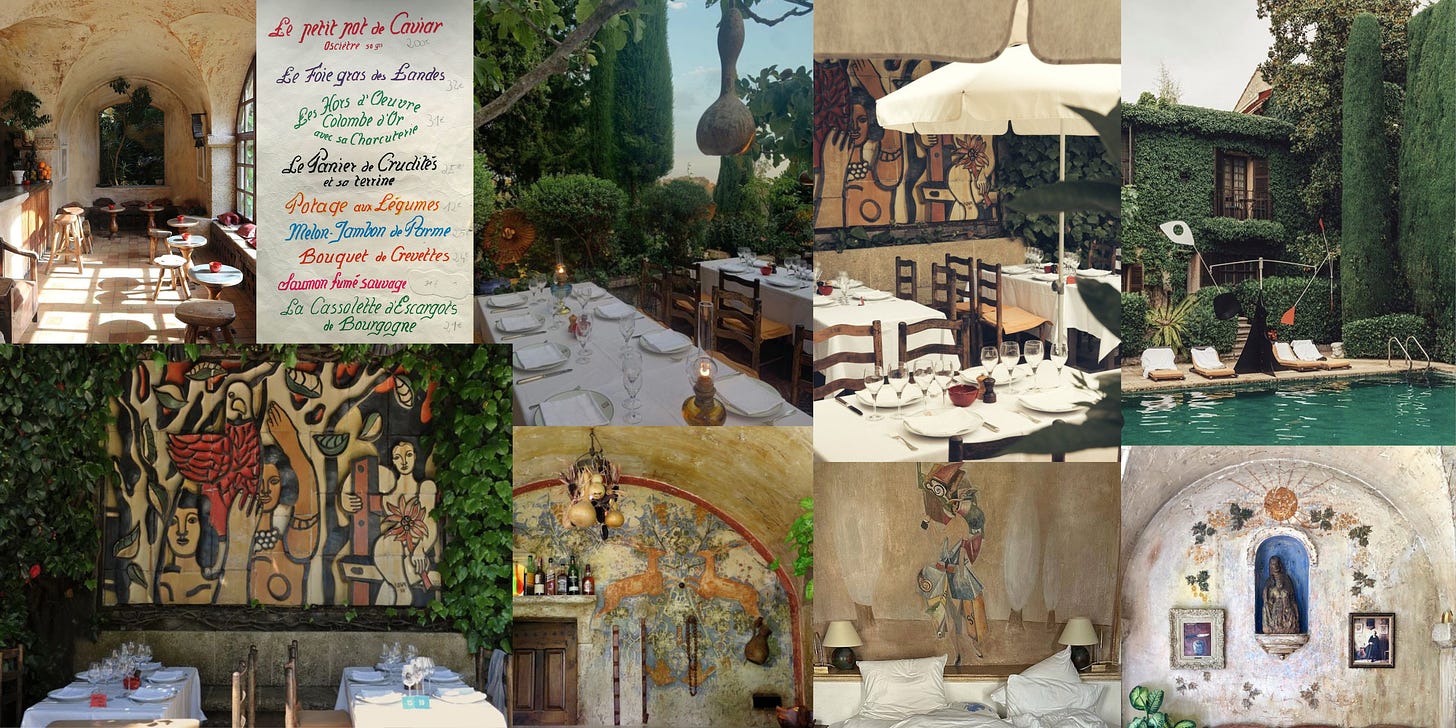Happy Sunday and welcome back to Giselle daydreams! This post is the sequel of this post in which I chose to feature seven daydreaming villas for this series split in two parts.
Villa Santo Sospir
Villa Santo Sospir is a remarkable villa located in Saint-Jean-Cap-Ferrat famously known for its unique artistic transformation by the legendary French artist Jean Cocteau. The villa is a fusion of art, architecture, and personal history, making it a cultural and artistic treasure.
The villa was purchased by Francine Weisweiller in the late 1940s. She was a wealthy socialite and patron of the arts who befriended Jean Cocteau in 1950. Cocteau, a poet, filmmaker, and visual artist, became a close friend of Weisweiller, and during his extended stays at the villa, he began to leave his artistic mark on its interiors.
Cocteau described his work at Villa Santo Sospir as tattooing the walls. Instead of hanging traditional paintings, he covered the walls, ceilings, and even some of the furniture with murals. He used a technique known as fresco, which involves painting on freshly applied plaster.
Cocteau’s murals throughout the villa depict scenes from Greek mythology, biblical stories, and personal symbols. These figures from ancient mythology include such as Apollo, Orpheus, Dionysus, and other gods and muses. These drawings blend into the Mediterranean setting, with motifs of gods, sea creatures, and classical figures. The villa's artistic decorations give the sense that it is an inhabited work of art, with every room telling a story, much like an illustrated manuscript.
Cocteau’s signature style, characterised by simple yet expressive lines and symbolic imagery, is evident throughout the villa. Cocteau’s work at Santo Sospir reflects his fascination with the Mediterranean, combining classical themes with a modern, almost dreamlike interpretation.
Cocteau did not work alone at Villa Santo Sospir. He collaborated with his friend, artist Jean Marais, and later on, the decorator Edouard Dermit, who helped complete the villa’s transformation into a total work of art.
The villa also served as a set for Cocteau’s short film La Villa Santo Sospir (1952), which documented the creative process behind the murals and the life at the villa. The film captures the intimate atmosphere of the villa, blending art and daily life. The villa is often referred to as a living canvas, as Cocteau’s interventions extended to the villa's tapestries, mosaics, and even the floor tiles. Cocteau returned to the villa repeatedly until he died death in 1963, and the house remained untouched after his work was completed, preserved in its original artistic form.
Today, Villa Santo Sospir stands as a monument to Jean Cocteau’s vision, reflecting his multidisciplinary talents as a poet, painter, and filmmaker. The villa is private but has been opened to the public for special tours, offering visitors a glimpse into this unique collaboration between Cocteau and Weisweiller. Villa Santo Sospir is a testament to how art can transform an everyday space into a poetic world.
Palais Bulles
The Palais Bulles (Bubble Palace) is a unique and futuristic residence located in Théoule-sur-Mer, near Cannes. Designed by Hungarian architect Antti Lovag between 1975 and 1989, the Palais Bulles is famous for its bubble-like forms and organic, fluid design. It was commissioned by Pierre Bernard, and later owned by French fashion designer Pierre Cardin, who used it as a holiday home and event space.
The architecture of Palais Bulles is based on the concept of organic forms. Antti Lovag was inspired by the shapes and patterns found in nature, particularly the curved, bubble-like structures that dominate the building’s design. The spherical rooms and spaces flow into one another, creating a sense of fluidity and harmony with the surrounding environment. Lovag famously disliked straight lines and angles, considering them to be "aggressive." The entire design is meant to evoke softness and movement, resulting in rounded spaces, walls, and windows. The bubble-like shapes are intended to create a more human-friendly living environment. The palace is built into the rocky cliffs of the Esterel Massif, blending into the natural surroundings. Its terracotta-coloured exterior mirrors the colour of the rocks, further enhancing the building’s organic integration with the landscape.
The villa consists of 10 interconnected bubble-like rooms with curved walls and circular windows. Each room has its own unique function and character, from the reception hall to the bedrooms, and offers panoramic views of the Mediterranean Sea. The interior design mirrors the exterior's fluidity, with curved furniture, rounded doorways, and integrated seating areas that complement the organic forms. Much of the furniture is custom-made to fit the unusual shapes of the rooms. The interiors are dominated by warm earth tones, with large, round windows that allow natural light to flood the rooms. The windows, which are also circular, provide stunning views and create a playful interplay of light and shadow.
The Palais Bulles features extensive outdoor areas, including multiple terraces, gardens, and a swimming pool. These outdoor spaces offer a continuation of the interior's flowing, organic design, with curved seating areas and bubble-shaped balconies that follow the contours of the villa. One of the most iconic features of the Palais Bulles is its 100-seat amphitheatre, which is integrated into the hillside and often used for private events, fashion shows, and performances.
When Cardin acquired the property in the early 1990s, he infused the villa with his futuristic style, making it a symbol of avant-garde architecture and fashion. Under Pierre Cardin’s ownership, Palais Bulles became a cultural hotspot, hosting numerous fashion shows, art exhibitions, and exclusive events, including the Cannes Film Festival after-parties, which helped elevate the villa’s status as an icon of modern design. While the Palais Bulles is a private residence, it continues to serve as a venue for special events and photo shoots.
Palais Bulles is a landmark in experimental architecture and is often cited as one of the most daring and unusual homes in the world. Lovag’s focus on creating spaces that mimic nature's forms has influenced generations of architects, particularly those interested in biomorphic and organic architecture.
Antti Lovag's vision for the Palais Bulles was rooted in the belief that traditional architecture, with its straight lines and rigid forms, was unnatural for human living. Instead, he sought to create spaces that evoked the womb-like comfort of nature. The villa’s curvaceous design is meant to be a playground for the senses, where movement and creativity are encouraged.
The Palais Bulles is a striking example of avant-garde architecture, merging futuristic aesthetics with a deep connection to the natural world. Its organic forms, luxurious interiors, and cultural significance make it one of the most iconic and unconventional homes in the world, embodying both the bold vision of Antti Lovag and the influential taste of Pierre Cardin.
La Colombe d’Or
La Colombe d'Or is a legendary hotel and restaurant located in the small village of Saint-Paul-de-Vence. Known for its artistic heritage and connection to some of the most famous artists of the 20th century, La Colombe d'Or has become a cultural landmark on the French Riviera, blending history, art, and a warm, rustic ambience.
La Colombe d'Or was originally established in 1920 by Paul Roux and his wife, Baptistine, as a small café-bar in Saint-Paul-de-Vence. Over time, it expanded into a hotel and restaurant which began attracting local artists, writers, and intellectuals. By the 1930s, La Colombe d'Or had become a popular destination for artists like Henri Matisse, Marc Chagall, and Georges Braque, who came to Saint-Paul-de-Vence for its beauty and light.
One of the most famous aspects of La Colombe d'Or's history is the tradition of artists paying for their stay or meals by offering their artwork to Paul Roux. This bartering system led to the creation of one of the most unique and valuable private art collections in the world, on display for guests to enjoy.
La Colombe d'Or boasts an extraordinary collection of original artwork by some of the 20th century’s greatest artists. The walls of the hotel and restaurant are adorned with works by Pablo Picasso, Fernand Léger, Alexander Calder, Joan Miró, and Georges Braque, among others. Sculptures by Calder, including a mobile, can be found in the garden.
The restaurant at La Colombe d'Or is famous for its traditional Provençal dishes made from fresh, local ingredients. Guests can dine surrounded by masterpieces from the greatest artists of the 20th century, making the experience more than just a meal — it is an immersion in art and history. The terrace, shaded by century-old trees, offers stunning views of the surrounding countryside and Saint-Paul-de-Vence.
Over the decades, La Colombe d'Or has attracted prominent artists, writers, actors, and celebrities. Picasso, Matisse, Chagall, and Calder were all regulars, as were filmmakers and actors like Yves Montand, Simone Signoret, and Orson Welles. Today, it continues to be a haven for celebrities and art lovers who seek the charm and exclusivity of this unique hideaway.
La Colombe d'Or has long been a source of inspiration for artists and writers, thanks to its bohemian atmosphere, its stunning location, and the presence of like-minded creatives. It has also appeared in various films and works of literature.
The hotel portion of La Colombe d'Or features a limited number of rooms, offering an exclusive and intimate atmosphere. Each room is individually decorated, often with original artworks from the hotel's collection. The décor mixes Provençal charm and artistic heritage, creating a unique blend of history and comfort.
Saint-Paul-de-Vence is a picturesque mediaeval village that has long been an artists’ colony. The narrow, cobbled streets are filled with galleries and boutiques, and the village’s charm and history have drawn countless visitors over the years.
Marc Chagall, who was previously living in Vence decided to settle in Saint-Paul-de-Vence in 1966 when he was 80 years old and spent his late life in the village until he passed away in 1985. He is buried in the local cemetery.
La Colombe d'Or is much more than just a hotel or restaurant; it is a living museum, a cultural institution, and a symbol of the artistic heritage of the French Riviera.
I hope you enjoyed today’s post and feel inspired to visit these villas.
Giselle xx







oh I am obsessed with this
Imagine if Hobbit was filmed in the Pallais Bubles 😅